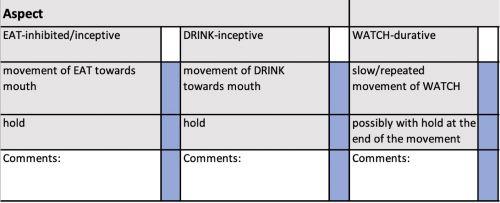Narrative Production Test for German Sign Language
The Narrative Production Test for German Sign Language (NaKom DGS) assesses narrative and morpho-syntactic competences in deaf children 4-11 years old. This test is an adaptation of the British Sign Language Production Test (Narrative Skills) by Herman et al. (2004). The NaKomDGS was developed by Vera Kolbe in cooperation with Claudia Becker in the Department of Sign Language Pedagogy and Audio Pedagogy at Humboldt-Universität zu Berlin, Germany.
NaKom DGS assesses content, structure and correct narrative sequence in children´s DGS narrations as well as use of depicting signs, directional modifications, aspect and manner and constructed action.
The standardization sample consists of narrations of 72 native signing children with access to DGS from birth through Deaf DGS signing parents. 65 children of the standardization sample are Deaf native signers, 7 are hearing CODAs (Children of Deaf Adults). The children in the standardization sample are between 4 to 11 years old.
NaKom DGS is intended for use with children who use DGS as a first language or who are multilingual with DGS and other languages.
NaKom DGS elicits narrations via a short language-free stimulus video. The children narrating the video story in DGS are filmed. The filmed narration is subsequently analyzed using an Excel score sheet. Individual test results of children are compared with the percentiles of the standardization sample. Percentiles are provided for every age. Test administration takes about 15 minutes per child and test evaluation between 30-60 minutes per test.

NaKom DGS is available in the context of a certification course for professionals and scholars at KoRa (Humboldt-Universität zu Berlin): https://kora-berlin.de
Results of the adaptation study and information about the test in DGS, German, English and International Sign can be found here: https://nakom.hu-berlin.de/
The test instrument was controlled for the following psychometric properties: validity, reliability, practicability as well as child appropriateness.
NaKom DGS achieved good results in all psychometric measures:
Internal consistency
- Cronbach´s α (n = 72): narration 0.94, grammar 0.88
Interrater-reliability
- Cohen´s κ (n = 21): narration 0.71, grammar 0.68; Many-Facet-Rasch-Measurement: very good consistency in rater severity
Intrarater-reliability
- Cohen´s κ (n = 10): narration 0.79, grammar 0.86
NaKom DGS provides information about the development of children´s competences according to age in all categories tested. For all categories a statistically significant effect of age is estimated by a General-Additive-Model regression.
One of the strengths of NaKom DGS is the assessment of sign language production, and not reception, thus it is not limited by variations in DGS. There is no language used in the stimulus video. The testers sign the test administration explanations and questions personally, therefore the DGS can be adapted to the variation familiar to the evaluated children.
A weakness lies in the complexity of evaluating a signed narration. Testers need to learn how to assess the produced children´s narrations in a certification course.
